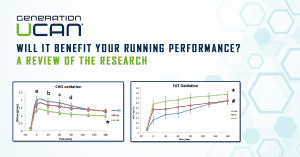Since Gatorade was first introduced in 1965 by a University of Florida medical team, researchers have sought to understand a sports drink’s effects on athletic performance.
Gatorade, and the later developed competing sports drinks, were designed to give athletes a convenient way to replace the fluids and electrolytes lost in perspiration and the carbohydrates burned in intensive exercise.
A flavorful and refreshing beverage available on the athletic field seemed to be the best solution – thus, Gatorade was born.
Over the years, the athletic field has extended to the running course where the utilization of fluid stations at long distance events and the development of water bottles, fuel belts and CamelBaks have solidified the beverages’ role as a runner’s mainstay.
It is now easy to access sports drinks while out on a run, but the availability of so many varieties can be overwhelming and leave us wondering which to use and when and how to use them. Hopefully this article will provide clarity.
How to select a sports drink
When developing a sports drink, manufacturers aspire to create a readily and quickly absorbable product that will tread lightly on the body’s digestion while running.
The term “gastric emptying” refers to how quickly a drink leaves your stomach so that the fluids and carbohydrates can be absorbed into the bloodstream. The fluid (water) in a sports drink helps maintain a stable blood volume and offset sweat losses. The carbohydrates (sugars) help maintain stable blood glucose levels as well as provide energy to the working muscles. Gastric emptying of a sports drink, and thus how quickly these processes are able to happen, is determined by the concentration of the solution and the volume ingested.
Research has shown that the most efficient and effective sports drinks have a carbohydrate concentration of 6 – 8 percent and absorb into the bloodstream quickly, at about the rate of plain water.
In comparison, the 10 to 12 percent carbohydrate concentration in soft drinks and fruit juices slows the stomach emptying and increases the cramping and other GI disturbance risks.
Fluid volume also determines how quickly your stomach will empty as the more distended your stomach becomes, the more quickly liquids will empty from your stomach.
Dehydration, on the other hand, slows down the rate of gastric emptying which is why it is important to drink early on and prevent dehydration. We will discuss fluid volume more in a bit.
Does the sugar type make a difference?
The fluids in an optimally formulated sports drink are absorbed just the same as water; however, the precise carbohydrate content in each has a greater variation range and is absorbed in the body via different mechanisms.
The most common carbohydrate forms are glucose and fructose (monosaccharides), sucrose (disaccharide formed from glucose + fructose), and maltodextrin (a polysaccharide also referred to as glucose polymers).
Early research on sports drinks concluded that the maximum amount of a single form of carbohydrate that could be absorbed during exercise was about 1 gram per minute. Once the glucose transporters are saturated, the body cannot absorb any additional sugar in the form of glucose no matter how much is given.
Recent research has since shown that the body can increase CHO absorption to 1.5 grams of glucose per minute when multiple carbohydrate forms are combined.
This is because the different sugars use different transport mechanisms to pass through the intestinal wall. Fructose uses a different intestinal transporter so the body can continue to absorb sugars via that mechanism after the glucose transporters are saturated. The result is more carbohydrate being available as fuel and less sitting in the stomach and potentially causing cramping or other GI problems.
The research on absorption and sugar combinations
Dr. Jeukendrup at the University of Birmingham School of Sport and Exercise Sciences has conducted a great deal of research on sports drinks and carbohydrate absorption and oxidation rates.
In 2008, eight trained male cyclists participated in a randomized crossover study in which they consumed either water, a glucose-only beverage, or a 2:1 ratio glucose and fructose beverage.
The beverages were ingested before exercise, at 15 minute intervals during two hours of steady state cycling, and at three separate intervals during a time trial immediately following the steady state ride.
Results showed that ingesting a 2:1 ratio glucose and fructose beverage improved time performance by 8 percent compared with just glucose and an 18 percent improvement compared with just water.
Results from cycling studies of this nature can generally be applied to running as well, since in later studies when measured during both cycling and running at a moderate intensity, absorption rates were similar. (Pfeiffer et al. 2011).
Researchers concluded that a mixed carbohydrate beverage that includes fructose, increases absorption and subsequent oxidation of carbohydrate.
Jeukendrup has researched additional sugar combinations that include fructose (glucose + fructose, maltodextrin + fructose, and a mixture of glucose, fructose, and sucrose) and has seen similar absorption and oxidation rates.
The following is a list of common brands of sports drinks and the sugars they contain:
- Accelerade — Ingredients: Sucrose, fructose, maltodextrin; 8 percent carbohydrates
- Cytomax — Ingredients: Fructose, maltodextrin, polyactate, glucose; 8 percent carbohydrates
- EFS– Ingredients: Complex carbohydrates, sucrose, dextrose; 8 percent carbohydrates
- Gatorade — Ingredients: Sucrose, glucose; 6 percent carbohydrates
- GU Electrolyte Brew — Ingredients: Maltodextrin, fructose; 5 percent carbohydrates
- HEED — Ingredients: Maltodextrin; 5 percent carbohydrates
- Power Ade — Ingredients: Fructose, sucrose; 6 percent carbohydrates
- PowerBar Endurance Sports Drink — Ingredients: Maltodextrin, dextrose, fructose; 7 percent carbohydrates
When to use sports drinks
While the studies mentioned above suggest that ingesting a sports drink during training may enhance performance, a sports drink is appropriate only for a particular workout length and intensity.
In 2010, Rollo and Williams determined that ingesting a 6.4 percent carbohydrate-electrolyte solution at 15 minute intervals during a one-hour run did improve performance or reduce perceived exertion compared with a placebo. The high-carbohydrate meal participants consumed three hours before the run likely provided all of the carbohydrates needed to complete the one-hour test.
However, consuming sports drinks during longer workouts can help maintain blood glucose and deliver additional fuel to working muscles in order to delay fatigue and improve your end-of-workout performance.
The general rule is using sports drinks for steady state endurance runs lasting longer than 90 minutes or high-intensity workouts lasting about 60 minutes.
The following guidelines provided by Monique Ryan in her book Sports Nutrition for Endurance Athletes, 3rd edition can be useful when determining whether or not you should bring a sports drink along with you on your next run.
Under 45 minutes: probably not needed
You may consider bringing along a sports drink if the workout is very high intensity or you have multiple training sessions that day
45-70 minutes: up to 30 g of carbohydrate per hour
If you have an early morning workout and haven’t had breakfast, or your workout is several hours after your last meal, carbohydrates provided by a sports drink may be beneficial if consumed during the workout
1-2.5 hours: 30-60 g of carbohydrate per hour
Uses these runs to practice and refine your fueling plan to meet your hydration needs while minimizing GI discomfort. Start drinking early and drink at regular intervals of 15-20 minutes.
More than 2.5 hours: 80 – 90 g of carbohydrates per hour
Products that provide multiple sources of carbohydrate are required to absorb a high rate of carbohydrate. Additional products like gels, bars, or gummies may be needed to meet carbohydrate needs.
Final Tips
- When you consume a sports drink, aim for regular intervals of 15-20 minutes and at least 20 ounces (2.5 cups) for each hour of the workout. Keep in mind that you don’t have to drink the entire amount at once.
- One big gulp is about 1 ounce of fluid, so try taking 4 big gulps at every drinking interval and you should be set.
- Sports drinks providing at least two sources of carbohydrate may have an advantage over those with just one
- Individual stomachs will react differently to the sugars contained in different sports drinks so it is important to experiment and determine what works best for you
- Cool fluids empty from your stomach more quickly that warm fluids so try to find creative ways for keeping your fluids cool on the run
- Sports drinks are not health drinks- they contain a high amount of sugar just like soft drinks and sweets so they should be saved only for long or intense workouts that demand carbohydrate replenishment
References
2. Pfeiffer B, Stellingwerff T, Zaltas E, et al. Carbohydrate oxidation from a drink during running compared with cycling exercise. Medicine & Science in Sports and Exercise, 2011;43(2):327-334.
3. Rollo I, Williams C. Influence of ingesting a carbohydrate-electrolyte solution before and during a 1-hour run in fed endurance-trained runners. Journal of Sports Sciences, 2010;28(6):593-601.
4. Ryan M. Sports Nutrition for Endurance Athletes, 3rd ed. Boulder, Co.: VeloPress; 2012.





9 Responses
I’m unenthused about sports drinks in general, because they strike me as almost entirely artificial and therefore not falling into the category of “food.” Instead, I’ve been quite happy with iskiate, and I wrote up an article about for the local running store here in Ithaca, the Finger Lakes Running & Triathlon Company. Any thoughts about how iskiate compares to these sports drinks?
https://docs.google.com/document/d/1dSC6PeCvo2pZY41hFIJ3YIhJe1-pDXXiyOhkYvUNdis/pub
cheers… -Adam
Hi Adam, thank you for your comment and thank you for sharing your article. A chia seed beverage (iskiate) seems like an interesting idea, although it also seems like it would take some getting used to in flavor and texture! Nutritionist Abby Housefield previously wrote a blog on chia seeds that can be found here:
I agree that sports drinks are very artificial. That is not a fact that is hidden from us. As athletes, we look for convenient ways to get the fuel we need to compete as hard as our bodies will allow us. In exchange, we must accept the fact that most of these products will be scientifically engineered and contain artificial ingredients. I could do without the dyes and artificial flavorings and just consume sugar water with added electrolytes. However, we are often at the mercy of what will be offered to us on the race course or what we can conveniently access while training. Most often that means getting used to the commercial sports drinks that are currently available. Because sports drinks often have a similar nutrition profile to soda pop and other soft drinks, I recommend saving them for race day or hard training sessions. If you are able to engineer your own products and have them available to you during training and at races, that is even better.
Great article – thanks! Curious what you think of Nuun and similar products. I’ve read some nutritionists who say that you should never drink just plain water unless it is with food – but instead should put some electrolytes and nutrition (like Nuun) into the water you drink throughout the day. What are your thoughts?
Good question, Ric. Here is an article we did on electrolyte tabs like Nuun: https://runnersconnect.net/running-nutrition-articles/electrolytes-for-runners/. I think it’s fine to drink just water. While you’ll just urinate out most extra electrolytes (so they’re pretty safe), it’s not super hard to replenish if you pay attention to pre and post run hydration.
I’m doing an experiment on “How are blood glucose levels affected by glucose drinks, of varying concentration, over a two hour period?” and I was searching for normal sports drink glucose concentrations and this website helped me a lot. I was wondering though, how long does it take for the glucose levels to be absorbed by the body, into the blood stream? It did not say specifically so… Also, on another website, the concentration was stated as 4.4% but on this website it said 6-8% can I trust this figure?
Hi Cole, glad you enjoyed the post. Our data came from scholarly articles from research completed on athletes to determine the best combination of carbohydrate solutions. Of course we can never know for certain, but experiments like the ones we used in our references are usually pretty accurate. Glucose is absorbed in around 20 minutes, but depends on what stage of the race you are in. That is why we recommend starting your fueling early, and continuing to top up throughout the race. Hope this helps! You can also check out this article on how to prevent hitting the wall. This may also have some useful information for you https://runnersconnect.net/running-nutrition-articles/how-to-avoid-hitting-the-wall-during-the-marathon/
Hi! Thank you for this really interesting post 🙂 I have been experimenting with gels (bad tummy), sports drinks (not always available at races or they run out sometimes though very effective). I found a tip from a wholistic running page)- maple syrup & coconut oil with a pinch of Himalayan sea salt. The runner is an ultramarathoner & she suggested making little ‘shots’ of these in small bags to refuel during longer runs. What are your views on this sugar/oil/salt formula? [it sounds tasty
Interesting find Nazzy, thanks for sharing! I am afraid that is a combination we have not heard of, as people are constantly trying new things. As we mentioned in this article, if it works for you, then keep using it! It would be best to try it out, and see how your stomach handles it. One thing your runner friend mentioned is small bags, which means she takes it in regularly, which is one of the most important parts, it would definitely make sense that it would work! Let us know how you get on!
Very nice post. I just stumbled upon your weblog and wanted to say that I’ve really enjoyed
surfing around your blog posts. In any case I’ll be subscribing
to your rss feed and I hope you write again very soon!